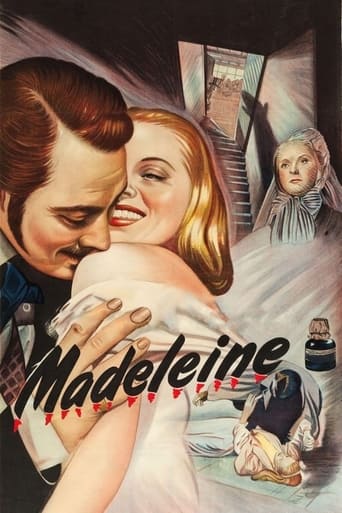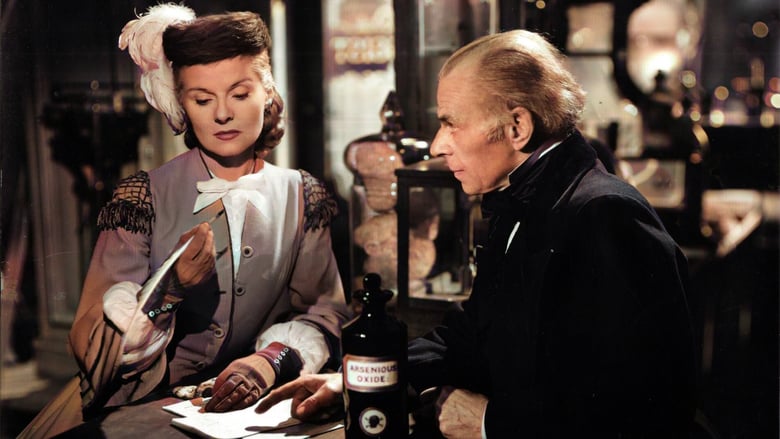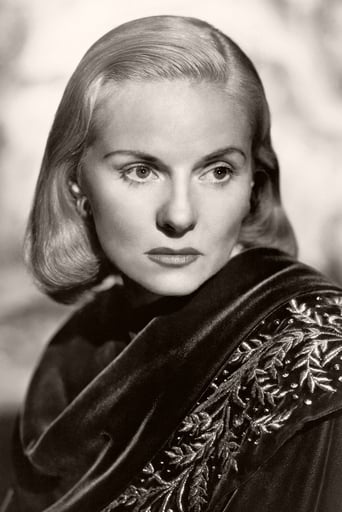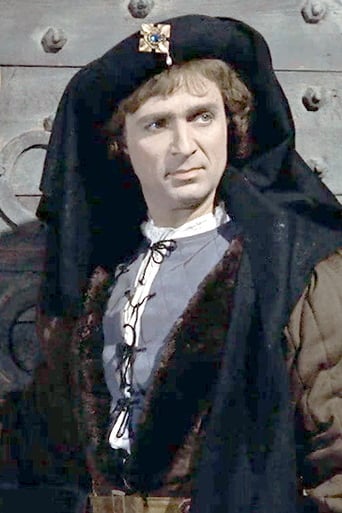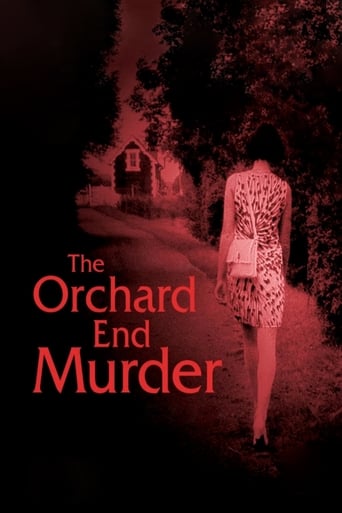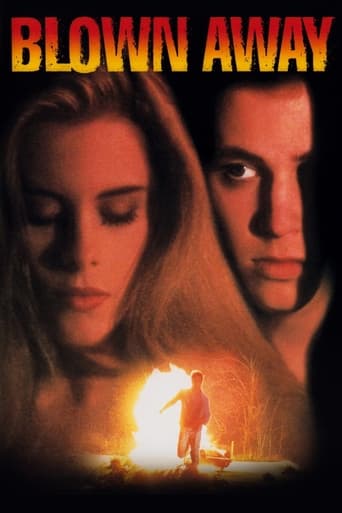Madeleine (1950)
The middle-class family of a young woman cannot understand why she delays in marrying a respectable young man. They know nothing about her long-standing affair with a Frenchman.
Watch Trailer
Cast
Similar titles

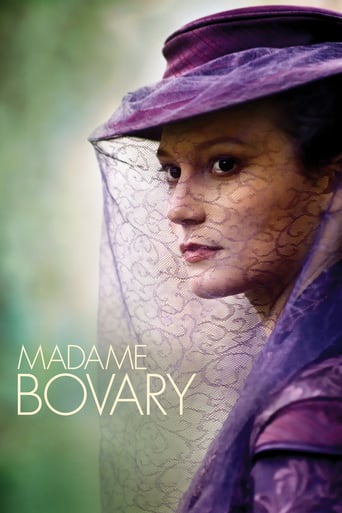
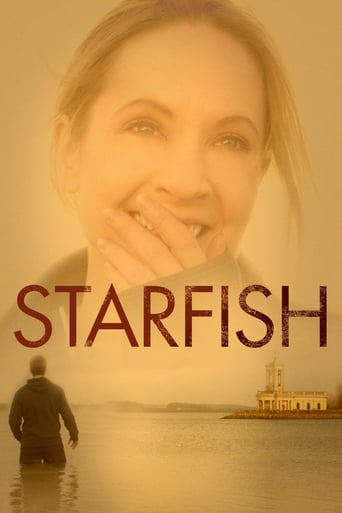
Reviews
the audience applauded
I don't have all the words right now but this film is a work of art.
Good , But It Is Overrated By Some
As Good As It Gets
It is ironic that this movie is based on real events and the names have not been changed yet perversely - especially for the time - director Lean declines to show how the two lovers from such disparate backgrounds ever got together in the first place. Instead, we are presented with a fait accompli - they are an item end of story. This really isn't good enough more so since Lean does go out of his way to portray Mr Smith as a martinet in the Moulton Barratt mould and it's is almost impossible to believe that Madeleine would have had sufficient freedom to become acquainted with her low-born French lover. Yet because it is a true story they clearly did meet and fall in love in greatest secrecy and it is surely not asking too much to let us in on the facts. The first half is pure Washington Square with a plain but wealthy girl being seduced by a good-looking pauper intent on social climbing but then it becomes something else entirely once arsenic rears its ugly head. Credibility is strained again when the friend who shares a room in the rat-hole in which the lover lives informs Mr Smith that he is attached to the French Consul. Of course you are, Froggy, all Consul employees live in rat-holes, natch. There's even a nod to a previous Todd box-office hit when her lover - who always carries a cane - asks her to play the piano for him, stopping short of adding if you won't play for me you'll play for no one. The direction is competent but no better than ho hum and that goes for the acting as well.
Excellent and unjustly overlooked David Lean film starring his then-wife Ann Todd, "Madeleine" is terrific drama, and perhaps one of Lean's best-directed films. Todd is the young Glasgow beauty Madeleine Smith, brought to trial in 1857, accused of murdering her lover by lacing his cocoa with arsenic. In sensational scenes, Madeleine was allowed to walk free, proved neither guilty or innocent through a lack of evidence. Lean takes an interesting approach with his subject matter here. The casting of Ann Todd, a blonde, glacial and enigmatic presence serves to be the director's strong point, as the ambiguity of Madeleine Smith's motivations are increased.Cinematographer Guy Green worked with Lean on the two Dickens adaptations before this film, and he once again shows absolute mastery of black-and-white images in this film. There are many strikingly composed shots in this film, not least the scenes between Todd and her lover, played by Ivan Desny. Madeleine hands him his cup of cocoa, and the shot is framed so the cup is in the foreground, alerting the viewer's attention and questioning Madeleine's motives as she focuses on the drink. At once we suspect her, knowing she has bought and used arsenic, but then doubt creeps back into our mind. Why would she let the young shop clerk and her maid both witness her buying arsenic, when it would have been much more clever of the woman to procure the poison by less public means? Another striking scene has Madeleine's tryst with her lover played out in the dark of night as she removes her shoes and dances to a Scottish song playing in the distance. At once Madeleine is free of the ties that bind her in the staid Victorian England, and her joyful, seductive dancing is inter-cut with rollicking, very physical scenes at the dance. Soon Madeleine is on the ground, losing her shawl. We fade to black, and Lean has very implicitly informed us about the nature of their relations.The acting is generally very good, with the leading players adding authenticity to their roles. Norman Wooland plays the wealthy, upstanding young man who courts Todd while she is still carrying on an affair with Desny. Elizabeth Sellars is also memorable as Todd's maid.Most historians believe the woman was guilty of the crime, as she certainly was in possession of arsenic in the weeks leading up to her lover's death, but Lean chooses to direct in a detached manner, and by the film's end we are still pondering "Did she or didn't she?". Todd gives a curious half-smile to the camera in the final close-up shot. Is it a smile of a woman who has survived a terrible ordeal, or the smile of a murderer?
It should come as no surprise that the trial of MADELEINE may well have been termed "the trial of the century" in 1857's Scotland. And from this true story, David Lean has made a period romance starring ANN TODD as the scheming woman from a wealthy background who feels compelled to hide her love affair with a commoner from her disapproving father.Madeleine defies the conventions of her stiff upper-class household and, after receiving a proper gentleman caller with her family, retreats to her private room where she has an assignation with a lover who is not a man of means. The shadowy interiors suggest the menace to come, as her father urges her to take a suitable suitor in marriage as soon as possible.What hurts the story is the familiarity of it all--a woman of substance wanting to break out of the social boundaries of convention. And unfortunately, there is nothing novel or different about this version of such a tale to make it of more than routine interest, despite the David Lean touch. What it really needed was Alfred Hitchcock's guiding hand.All of the technical ingredients are fine but the script is ultimately a disappointment and tends to be dull in spots. Furthermore, Ann Todd's Madeleine is not a very arresting character. This has to be considered one of David Lean's less effective films. The story is as emotionally cold as Madeleine herself and her demure behavior with her father seems more like a pose than anything else, one that he should easily be able to see through. Her arrest for murder in the poisoning of her lover is handled with too many frigid close-ups of Todd's face and no real explanation of what happened.It's certainly not a "must see" film by the renowned directed Lean.Best performance in the entire film: ANDRE MORELL as the defense counselor who gives the most stirring and satisfying speech in the courtroom as to why Madeleine should be found innocent of the circumstantial evidence.
In 1857 a citizen of Great Britain (from the Channel Island of Jersey) named Emile L'Angelier died after a brief illness in his rooms in a rooming house in Glasgow, Scotland. From comments he muttered his friend and his landlady wondered if his death was natural or from poison. For Emile mentioned that he had felt the same way the last time he saw "Mimi". The authorities found Emile had letters, initially love letters, but some seeming to show increasing agitation to end the relationship, and then the letters start encouraging the deceased to see his girlfriend. The author of these letters was Madeleine Smith, the daughter of a prominent architect in Glasgow. An autopsy revealed that Emile died of arsenic poisoning, not gastroenteritis or some other illness.Madeleine was from a very proper family, with a stern father. It was expected that she would make a proper marriage only - not to some nobody like Emile L'Angelier. And she was engaged to an older professional man, Mr. William Minnoch. But L'Angelier was socially ambitious, and wanted to advance in Glasgow society. This would be done by marrying into a wealthy family like Madeleine's. So L'Angelier would be less likely to want to end the relationship (and return those love letters), and be more willing to blackmail his girlfriend into marrying him. It was a bad situation, and only the death of L'Angelier or his marriage with Madeleine would have settled it.Madeleine was arrested, and tried in the High Court in Glasgow. She was defended by Scotland's greatest barrister of the day, John Inglis. Inglis managed to show great ambiguity over many points in the police case. This included the fact that L'Angelier treated himself with patent medicines (some containing arsenic). Also, that the melancholy L'Angelier had spoken of doing himself in occasionally. Nobody ever saw Madeleine and L'Angelier together on those past occasions where he became violently ill. Arsenic had been traced to Madeleine, but she claimed it was used on her pretty face to improve her complexion (which happened to be a use for arsenic). The end result was the jury returned the Scot verdict, "Not Proved". The evidence never was conclusive enough to result in conviction or acquittal.Her subsequent career was quiet but interesting. No further murders (at least none we know of). She did not marry Minnoch. Her family kept her at arms length. She moved to London, and showed some real spirit by embracing the socialist/labor movement. She married George Wardle, an artist who worked closely with fellow socialist William Morris, and had among her socialist friends George Bernard Shaw. Her marriage to Wardle collapsed after an argument in the 1880s. They divorced in 1889. She married a second time, moved to New York City, and she lived in the Bronx as "Lena Sheehy" (Sheehy was her second husband's name). She died in 1928, and is buried (as Lena Sheehy) in the Bronx.In 1950 David Lean was still in his "little movie" period. He was telling stories about regular people, like BRIEF ENCOUNTER on THIS HAPPY BREED, and was not ready to do his big spectaculars like BRIDGE OVER THE RIVER KWAI, LAWRENCE OF ARABIA, and DR. ZHIVAGO. MADELEINE was a type of bridging film, as it was his first attempt to do an historical movie. So it is longer than most of his films in this period. However, in this case the film could have been shed some of the first half hour (the scene where Ann Todd joins a Scottish dance might have been dropped), but the film as a whole remains good - and skittish. Although most people feel that Madeleine did poison Emile, there are many who think it was not her but Emile committing suicide and trying to frame his "Mimi" (who had dropped him), or overdosing on some arsenic based nostrum he took for his health. Lean's movie leaves it as it should be - an everlasting question-mark. Madeleine would have approved, perhaps, but to the end of her life she always denied she poisoned her lover.
